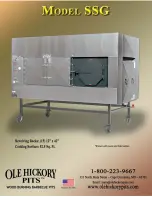
Installation instructions
en
37
20.7 Checking the correct burner behaviour
Check the burning and soot formation of each burner
after the product has been converted to a different gas
type. If there is a problem, compare the nozzle values
with the values in the table.
Checking the correct burner behaviour of the
cover burner
1.
Ignite the gas cooker burners in accordance with
the instructions in the operating manual.
→
"Operating the hotplate", Page 15
2.
Set the gas cooker knob to the small flame setting.
Check whether the flame safety system is working
by keeping the flame at the "small flame" setting for
one minute.
3.
Check that the burners are burning correctly with
both large and small flames.
a
The flame must burn evenly and steadily.
4.
Turn the burner knob back and forth quickly
between the large flame setting and the small flame
setting. Repeat this process several times.
a
The gas flame must not flicker or go out.
Checking the correct burner behaviour for the
lower oven gas burner
1.
Ignite the lower oven gas burner in accordance with
the instructions in the operating manual.
→
2.
Open the oven door and observe the flame.
a
The flame must burn evenly.
a
The flame may fail during the first few minutes. How-
ever, the flame must stabilise after a few minutes.
3.
Switch on the appliance for a few minutes to check
whether the thermocouple becomes sufficiently
warm.
a
Adjust the settings, if required. If the bypass nozzle
on the burner is faulty, replace this.
Checking the correct burner behaviour for the
lower oven gas burner
1.
Ignite the gas grill burner in the oven in accordance
with the instructions in the operating instructions.
→
2.
Open the oven door and observe the flame.
a
The flame must burn evenly.
a
The flame may fail during the first few minutes. How-
ever, the flame must stabilise after a few minutes.
3.
Switch on the appliance for a few minutes to check
whether the thermocouple becomes sufficiently
warm.
a
Adjust the settings, if required. If the bypass nozzle
on the burner is faulty, replace this.
20.8 Technical data – Gas
The different types of gas and the corresponding val-
ues are listed.
Information on some types of gas
Note the following information for the gas types that are
listed in the table for some burners.
Type of gas
Explanation
G20/25
(20/25 mbar)
For France and Belgium
G2.350
(13 mbar)
For Poland
G30 (50 mbar)
The after-sales service must order
the nozzle set HEZ298070.
Nozzle values for the auxiliary burner
Note the following information for the gas types that are listed in the table for some burners.
G20/
G25
G20
G20
G25
G25
G25.3
G30/G31
G30
G30
G27
Gas pressure (mbar)
20/25
20
25
20
25
25
28–
30/37
50
37
20
Nozzle (mm)
0.72
0.72
0.68
0.77
0.72
0.72
0.50
0.43
0.47
0.77
Bypass nozzle (mm)
0.50
0.50
0.50
0.50
0.50
0.50
0.30
0.30
0.30
0.50
Max. input power (kW)
1
1
1
1
1
1
1
1
1
1
Min. input power (kW)
≤0.55
≤0.55
≤0.55
≤0.55
≤0.55
≤0.55
≤0.55
≤0.55
≤0.55
≤0.55
Gas flow at 15 °C and
1013 mbar m
3
/h
0.095/
0.111
0.095
0.095
0.111
0.111
0.108
-
-
-
0.116
Gas flow at 15 °C and
1013 mbar g/h
-
-
-
-
-
-
73/71
73
73
-
Nozzle values for the standard-output burner
Note the following information for the gas types that are listed in the table for some burners.




































